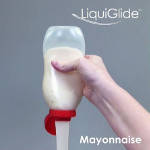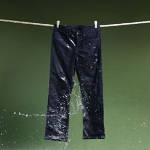
 LiquiGlide was created three years ago to market a revolutionary MIT invention: a patented liquid-impregnated surface technology. "A liquid-impregnated surface is a multi-layer surface, consisting of a customized solid texture and a liquid. The highly textured solid surface is composed of a matrix of features spaced sufficiently close to stably contain the impregnating liquid that fills in the spaces between the features. The liquid is held in place within the texture, creating a permanently slippery, liquid surface. The product is actually sliding on our liquid layer, in a liquid-to-liquid interface." That's how LiquiGlide explains the concept, and if it sounds a bit obscure, their various videos demonstrate how effective this is.
LiquiGlide was created three years ago to market a revolutionary MIT invention: a patented liquid-impregnated surface technology. "A liquid-impregnated surface is a multi-layer surface, consisting of a customized solid texture and a liquid. The highly textured solid surface is composed of a matrix of features spaced sufficiently close to stably contain the impregnating liquid that fills in the spaces between the features. The liquid is held in place within the texture, creating a permanently slippery, liquid surface. The product is actually sliding on our liquid layer, in a liquid-to-liquid interface." That's how LiquiGlide explains the concept, and if it sounds a bit obscure, their various videos demonstrate how effective this is.
 Each coating is developed according to the liquid's specifics, whether it's glue, toothpaste, nail enamel... or ketchup and mayonnaise. Orkla, a Norwegian food manufacturer, announced last week their agreement with LiquiGlide to use their technology for mayonnaise products in Northern Europe. One may be concerned about the slippery coating's risks on health, but LiquiGlide confirms that each coating can be made from food and is designed to be harmless and to meet all the required safety standards. Hopefully many food and grocery manufacturer will follow and allow us to enjoy our mayonnaise to the very last drop.
Each coating is developed according to the liquid's specifics, whether it's glue, toothpaste, nail enamel... or ketchup and mayonnaise. Orkla, a Norwegian food manufacturer, announced last week their agreement with LiquiGlide to use their technology for mayonnaise products in Northern Europe. One may be concerned about the slippery coating's risks on health, but LiquiGlide confirms that each coating can be made from food and is designed to be harmless and to meet all the required safety standards. Hopefully many food and grocery manufacturer will follow and allow us to enjoy our mayonnaise to the very last drop.
Photos: LiquiGlide / MIT
News in the same category
Adidas introduced a revolutionary swimsuit last month in Germany. According to them, the Adizero XVI swimsuit is the fastest ever.
How about a pair of jeans that doesn't need to be washed and still remains fresh and clean? This is not a dream anymore, since Odo Denim has figured out how to realise such a miracle.
When a guy working at Nest shops for Christmas presents but can't find a way to test the gadgets he found on the Internet, he opens a store. It's as simple as that.
Turning ocean plastic debris into sport shoes is adidas and Parley's way to show how industry can contribute to stop ocean pollution.




